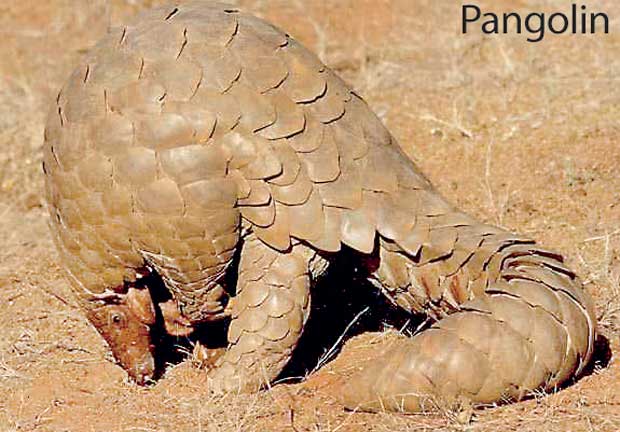09 Feb 2018 - {{hitsCtrl.values.hits}}

 The recent nabbing of a frozen pangolin in the kitchens of a Chinese restaurant in the heart of Colombo has shed a much-needed spotlight on the importance of curbing the illegal exploitation of these shy mammals, which are a globally endangered species and nationally a near threatened one.
The recent nabbing of a frozen pangolin in the kitchens of a Chinese restaurant in the heart of Colombo has shed a much-needed spotlight on the importance of curbing the illegal exploitation of these shy mammals, which are a globally endangered species and nationally a near threatened one.
There are four species of pangolin restricted to Asia. The one found in Sri Lanka is the Indian pangolin (Manis crassicaudata) and is commonly called the scaly anteater (Sinhala: ‘Kaballawa’, ‘Aya’; Tamil: ‘Alungu’). Pangolins can be identified by the distinctive scales, which cover their entire body and they are found in both the wet and dry zones of Sri Lanka.
Although pangolin meat, scales and bile have been used extensively in traditional Indian and Southeast Asian medicines, there is no evidence that pangolins in Sri Lanka were hunted for medicinal or Ayurvedic purposes. In Sri Lanka, pangolins are prized as bush meat. They usually get entangled in traps left for other animals such as porcupines and are consumed by local communities. There is no past evidence to suggest that a roaring illegal trade was present in the country.
Increasing market demand
Today, the Indian pangolin in Sri Lanka is under severe hunting pressure due to the rising demand for its scales and meat in East Asian markets, especially in the Chinese markets, according to the IUCN Red List 2018. The scales are either used whole or in powdered form in traditional medicines and as curios. The Indian pangolin’s skin has also been used in leather manufacturing, particularly as footwear.
The market demand in the species available in Sri Lanka is driven even more today by the fact that the numbers of the Chinese pangolin (Manis pentadactyla) and the Malayan pangolin (Manis javanica) have significantly fallen due to trafficking, forcing smugglers and illegal traders to look towards alternative species of pangolin, like the one present in Sri Lanka.
Booming illegal trade
It is suspected that the Indian pangolin populations worldwide will fall by at least 50 percent by 2039, if the demand and supply continue to rise unchecked. The IUCN has estimated that pangolin trade in just the last decade has seen over a million individuals crossing international borders, giving this shy mammal the dubious title of ‘World’s Most Trafficked Mammal’.
The market price for pangolins has been known to start at US $ 600 (Rs.100,000) for a kilogramme of scales and a kilogramme of meat can sell for anything upwards of US $ 250 (Rs.40,000). These values are double what they were in 2008, indicative of the growing demand.
According to the Environmental Investigation Agency, the known seizures of pangolin scales since December 2016 total more than 14 tonnes worldwide and around 20,000 individual pangolins may have been hunted to supply this amount. This is the conservative estimate and it’s alarming.
Last year, the Customs Department of Sri Lanka reported four cases of pangolin products being caught at Bandaranaike International Airport. In each case, the smuggler’s destination has been Chennai, India. The largest pangolin-related bust in Sri Lanka took place last year as well, when police in Kalpitiya discovered 130 kilogrammes of pangolin scales in the possession of five persons in a house near the Kalpitiya lagoon. Wildlife experts estimate that approximately 150 pangolins may have been killed to extract the skutes. Police reported that these scales were earmarked for export to India.
Pangolins are nationally protected in Sri Lanka by the Flora and Fauna Protection (Amendment) Act No. 22 of 2009 (included in Schedule ll). The National IUCN Red List (2012) lists it as a Near Threatened species in the country. It is listed as endangered in the Global IUCN Red List. This makes it illegal to hunt and be in possession of a pangolin or pangolin products within country borders (or any other wildlife or flora protected by the ordinance), and perpetrators stand to face penalties including fines and imprisonment.
A wake up call
The pangolin has never really penetrated into the public’s consciousness as a mammal which needs conservation in quite the same way that elephants or leopards have. This may be due to the fact that it is rarely seen by humans, being an elusive nocturnal eater of ants and termites. They also rarely survive in captivity. Only six zoos in the world have any, making it a mammal that is relatively unknown, especially in the West.
The recent nabbing of the frozen pangolin in Colombo has sparked public interest in protecting the local biodiversity and authorities such as the Wildlife Conservation Department should use the momentum created to strengthen efforts to protect this scaly mammal. The crackdowns must come fast and strong, in order the nip the growing local demand in the bud.
The Sustainable Development and Wildlife Ministry and other research bodies need to take up the mandate of carrying out more research regarding the numbers and habits of the pangolin in Sri Lanka. If not, we stand to lose this beautiful creature before we have even understood it.
The scourge of illegal wildlife trafficking has placed many species under enormous threat. The fight against it must become equally powerful in order to prevent mass extinctions in our generation.
(Amayaa Wijesinghe works as a research assistant at SLYCAN Trust. She studied biological sciences at the Zoology and Environment Sciences Department of the Faculty of Science, University of Colombo. Her research interests lie in the role natural ecosystems can play in helping the planet face climate change and is currently carrying out research on policies for adaptation and mitigation)
10 Jan 2025 55 minute ago
10 Jan 2025 1 hours ago
10 Jan 2025 2 hours ago
10 Jan 2025 3 hours ago
10 Jan 2025 3 hours ago